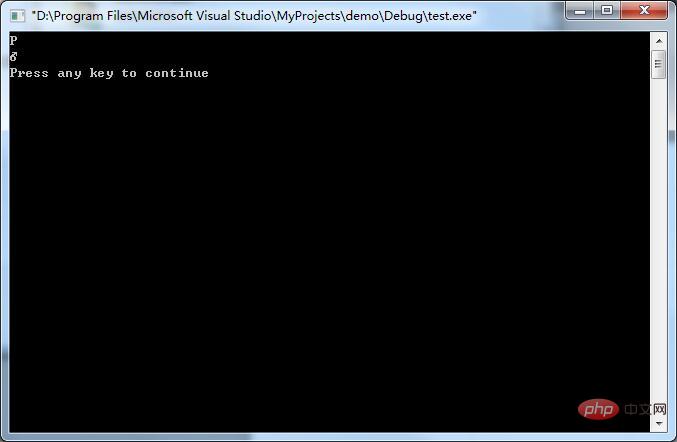What is the function of putchar()
The function of putchar() is to output a character to the terminal. putchar() is an output function with the syntax "putchar(char)". It can write the character specified by the parameter char (an unsigned character) to the standard output stdout. The output of the putchar() function can be a character, a decimal integer between 0 and 127 (including 0 and 127), or a character variable defined with char.

The operating environment of this tutorial: windows7 system, c99 version, Dell G3 computer.
putchar() is a function in C language. Its function is to output a character to the terminal.
The putchar() function is included in the C standard library
The syntax structure is:
int putchar(int char)
The character specified by the parameter char (an unsigned character) can be written to the standard output stdout.
Parameters:
char -- This is the character to be written. The character is passed with its corresponding int value.
Return value
This function returns the written character in the form of unsigned char cast to int, Returns EOF if an error occurs.
Explanation
This function outputs the characters corresponding to the value of the specified expression to the standard output terminal. . The expression can be a character type or an integer type, and it can only output one character at a time. For example: "putchar('#')" outputs the character "#".
putchar() function uses
Can the putchar() function only output char type data? With such doubts, I conducted verification on the environment. The verification results are quite interesting, so I would like to share them.
When we define a variable a and assign a value from 0 to 255, there is obviously no problem, such as the code:
#include<stdio.h>void main( )
{ int a = 0; //将0值赋给变量a
int b = 255; //将255值赋给变量b
putchar(a) ; //输出变量a的值
putchar(b) ; //输出变量b的值
putchar('\n') ;
}The result is obviously no problem.
But what if the assigned value is a negative number now? For example, the code:
#include<stdio.h>void main( )
{ int a = -4646; //将-4646值赋给变量a
int b = -2; //将-2值赋给变量b
putchar(a) ; //输出变量a的值
putchar('\n') ; putchar(b) ; //输出变量b的值
putchar('\n') ;
}found that the compilation is normal and the results can be output, but the output results are all empty. I am not sure why?
Another situation is, what happens when the assigned value is greater than 255? The code is as follows:
#include<stdio.h>void main( )
{ int a = 592; //将592值赋给变量a
int b = 267; //将267值赋给变量b
putchar(a) ; //输出变量a的值
putchar('\n') ; putchar(b) ; //输出变量b的值
putchar('\n') ;
}The running result is:

It can be found from the result that the assigned value is truncated into char type data, that is to say, only The lower eight bits of data are taken.
From these examples, the putchar() function does not check the true range of characters to be output.
Conclusion:
When using it, you need to pay attention to whether the range of the output variable is within the range of one character. Only within the range of one character can the correct output be achieved. Otherwise something will definitely go wrong.
Recommended: "c Language Tutorial"
The above is the detailed content of What is the function of putchar(). For more information, please follow other related articles on the PHP Chinese website!

Hot AI Tools

Undresser.AI Undress
AI-powered app for creating realistic nude photos

AI Clothes Remover
Online AI tool for removing clothes from photos.

Undress AI Tool
Undress images for free

Clothoff.io
AI clothes remover

AI Hentai Generator
Generate AI Hentai for free.

Hot Article

Hot Tools

Notepad++7.3.1
Easy-to-use and free code editor

SublimeText3 Chinese version
Chinese version, very easy to use

Zend Studio 13.0.1
Powerful PHP integrated development environment

Dreamweaver CS6
Visual web development tools

SublimeText3 Mac version
God-level code editing software (SublimeText3)

Hot Topics
 Concept of c language function
Apr 03, 2025 pm 10:09 PM
Concept of c language function
Apr 03, 2025 pm 10:09 PM
C language functions are reusable code blocks. They receive input, perform operations, and return results, which modularly improves reusability and reduces complexity. The internal mechanism of the function includes parameter passing, function execution, and return values. The entire process involves optimization such as function inline. A good function is written following the principle of single responsibility, small number of parameters, naming specifications, and error handling. Pointers combined with functions can achieve more powerful functions, such as modifying external variable values. Function pointers pass functions as parameters or store addresses, and are used to implement dynamic calls to functions. Understanding function features and techniques is the key to writing efficient, maintainable, and easy to understand C programs.
 What are the types of return values of c language function? Summary of types of return values of c language function?
Apr 03, 2025 pm 11:18 PM
What are the types of return values of c language function? Summary of types of return values of c language function?
Apr 03, 2025 pm 11:18 PM
The return value types of C language function include int, float, double, char, void and pointer types. int is used to return integers, float and double are used to return floats, and char returns characters. void means that the function does not return any value. The pointer type returns the memory address, be careful to avoid memory leakage.结构体或联合体可返回多个相关数据。
 Tutorial on how to represent the greatest common divisor in C language functions
Apr 03, 2025 pm 11:21 PM
Tutorial on how to represent the greatest common divisor in C language functions
Apr 03, 2025 pm 11:21 PM
Methods to efficiently and elegantly find the greatest common divisor in C language: use phase division to solve by constantly dividing the remainder until the remainder is 0. Two implementation methods are provided: recursion and iteration are concise and clear, and the iterative implementation is higher and more stable. Pay attention to handling negative numbers and 0s, and consider performance optimization, but the phase division itself is efficient enough.
 The concept of c language functions and their definition format
Apr 03, 2025 pm 11:33 PM
The concept of c language functions and their definition format
Apr 03, 2025 pm 11:33 PM
C language functions are reusable code blocks, receive parameters for processing, and return results. It is similar to the Swiss Army Knife, powerful and requires careful use. Functions include elements such as defining formats, parameters, return values, and function bodies. Advanced usage includes function pointers, recursive functions, and callback functions. Common errors are type mismatch and forgetting to declare prototypes. Debugging skills include printing variables and using a debugger. Performance optimization uses inline functions. Function design should follow the principle of single responsibility. Proficiency in C language functions can significantly improve programming efficiency and code quality.
 What are c language function pointers and pointer functions? What's the difference?
Apr 03, 2025 pm 11:54 PM
What are c language function pointers and pointer functions? What's the difference?
Apr 03, 2025 pm 11:54 PM
A function pointer is a pointer to a function, and a pointer function is a function that returns a pointer. Function pointers point to functions, used to select and execute different functions; pointer functions return pointers to variables, arrays or other functions; when using function pointers, pay attention to parameter matching and checking pointer null values; when using pointer functions, pay attention to memory management and free dynamically allocated memory; understand the differences and characteristics of the two to avoid confusion and errors.
 What are the formats of function definition in C language?
Apr 03, 2025 pm 11:51 PM
What are the formats of function definition in C language?
Apr 03, 2025 pm 11:51 PM
The key elements of C function definition include: return type (defining the value returned by the function), function name (following the naming specification and determining the scope), parameter list (defining the parameter type, quantity and order accepted by the function) and function body (implementing the logic of the function). It is crucial to clarify the meaning and subtle relationship of these elements, and can help developers avoid "pits" and write more efficient and elegant code.
 CS-Week 3
Apr 04, 2025 am 06:06 AM
CS-Week 3
Apr 04, 2025 am 06:06 AM
Algorithms are the set of instructions to solve problems, and their execution speed and memory usage vary. In programming, many algorithms are based on data search and sorting. This article will introduce several data retrieval and sorting algorithms. Linear search assumes that there is an array [20,500,10,5,100,1,50] and needs to find the number 50. The linear search algorithm checks each element in the array one by one until the target value is found or the complete array is traversed. The algorithm flowchart is as follows: The pseudo-code for linear search is as follows: Check each element: If the target value is found: Return true Return false C language implementation: #include#includeintmain(void){i
 How to use C language function pointer to find the maximum value of a one-dimensional array
Apr 03, 2025 pm 11:45 PM
How to use C language function pointer to find the maximum value of a one-dimensional array
Apr 03, 2025 pm 11:45 PM
Flexible application of function pointers: use comparison functions to find the maximum value of an array. First, define the comparison function type CompareFunc, and then write the comparison function compareMax(a, b). The findMax function accepts array, array size, and comparison function parameters, and uses the comparison function to loop to compare array elements to find the maximum value. This method has strong code reusability, reflects the idea of higher-order programming, and is conducive to solving more complex problems.






